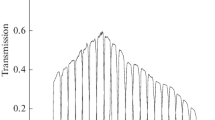Abstract
THE Abell catalogue1 contains 2,712 clusters, of which 1,682 form a homogeneous statistical sample, with clusters of richness R = 1 to 5. Murray et al.2 have analysed the entire sample of 2,712 Abell clusters with a set of uniform criteria which identify 21 superclusters. Their criteria are: (1) that clusters which belong to the supercluster are approximately equidistant from us; M10, the magnitude of the tenth brightest cluster galaxy, is allowed to range over ≤0.3 mag for the member clusters; (2) six or more such clusters are contained in a circle of radius θ centred on one of the clusters; and (3) θ ∼ 1.5° for a distance class-6 cluster and scales inversely with distance according to M10. These criteria identify high-multiplicity (n ≥ 6) superclusters, rather than groups which are predominantly binary and triplet clusters. While ∼40% of nearby Abell clusters are in low-multiplicity (n = 2, 3) groups3,4, only ∼6% of all Abell clusters are contained in the superclusters of high multiplicity. This letter shows (1) that clusters of galaxies which are located in superclusters (second-order clusters of ∼30 Mpc radius) are systematically richer than those in the ‘field’, and (2) that the expected higher X-ray luminosities of these richer clusters may, therefore, account for much, if not all, of the possibly large X-ray luminosities from superclusters.
Similar content being viewed by others
References
Abell, G. O. Astrophys. J. Suppl. 3, 211–288 (1958).
Murray, S., Forman, W., Jones, C. & Giacconi, R. Astrophys. J. Lett. 219, L89–L93 (1978).
Rood, H. J. Astrophys. J. 207, 16–24 (1976).
Hauser, M. & Peebles, P. J. E. Astrophys. J. 185, 757–786 (1973).
Bautz, L. P. & Morgan, W. W. Astrophys. J. Lett. 162, L149–L153 (1970).
Leir, A. & van den Bergh, S. Astrophys. J. Suppl. 34, 381–403 (1977).
Rood, H. J. & Sastry, G. N. Publ. Astr. Soc. Pacific 83, 313–319 (1971).
Perrenod, S. C. Astrophys. J. (in the press).
Abell, G. O. Stars and Steller Systems (eds Sandage, A., Sandage, M. & Kristian, J.) 9, 601–645 (University of Chicago Press, 1975).
Pravdo, S. et al. Nature 270, 158–159 (1977).
Culhane, L. I.A.U. Symp. No. 79 (1977).
Schwartz, D. Astrophys. J. 220, 8–13 (1978).
Author information
Authors and Affiliations
Rights and permissions
About this article
Cite this article
PERRENOD, S. Correlation between supercluster membership and richness for Abell clusters. Nature 274, 39–40 (1978). https://doi.org/10.1038/274039a0
Received:
Accepted:
Published:
Issue Date:
DOI: https://doi.org/10.1038/274039a0
- Springer Nature Limited




